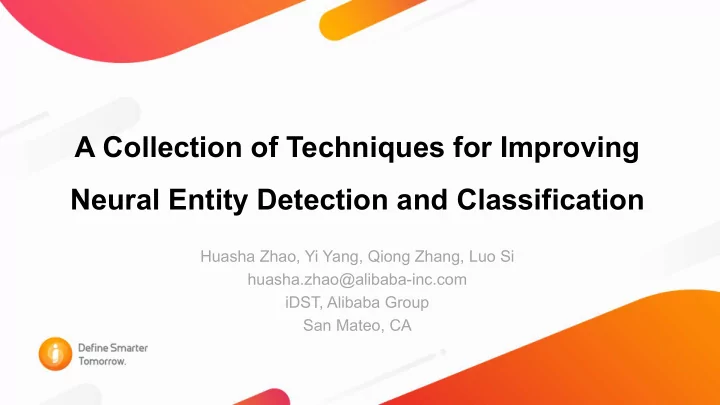

A Collection of Techniques for Improving Neural Entity Detection and Classification Huasha Zhao, Yi Yang, Qiong Zhang, Luo Si huasha.zhao@alibaba-inc.com iDST, Alibaba Group San Mateo, CA
Agenda • Introduction : Bidirectional LSTM-CRF • Features : Multi-Input Model • Training : Multi-Task Learning – Adaptive Data Selection • Prediction : Document-level Consistency – Dictionary-based – Model-based • Conclusions
Introduction: Bidirectional LSTM-CRF • Achieves state-of-the-art performance for many sequence labeling tasks • Generalize well due to simple model structure and few parameters • Very flexible architecture, easy to incorporate new ideas – Multi-input: include new features – Multi-task for transfer learning – natural for hierarchical architecture
Multi-Input Model: Architecture • Multi-Input model that includes embeddings from – word embeddings (GloVe) – character embeddings (BiLSTM) – entity embedding – gazetteer using freebase title – … • Entity embeddings – Token entity type distribution derived from a Wikipedia Name Tagger (Pan, 2017) – Construct embedding by concat such distributions w. additional position features
Multi-Input Model: Entity Embedding • Entity embedding feature significantly improve the NAM prediction by 3.3 F1 point • Freebase feature actually worsen the performance – Many common words entities – Potential improvement with page rank features • Dictionary constructed from other sources does not help either
Multi-Task Learning: Architecture • The hierarchical architecture of BiLSTM-CRF is very natural for multi-task learning . • Bottom components can be shared across task/domain.
Multi-Task Learning: Adaptive Data Selection • Multi-task training can alleviate some of the problem caused by data heterogeneity between target and source. • Data selection algorithm that further removes noisy data from source dataset. • At each iteration, data selection from the source domain is interleaved with model parameter updates. • Training data is selected based on a consistency score .
Multi-Task Learning: Experiments • We use ACE and ERE as source dataset and KBP as target • MT does not improve NAM at all • MT and data selection significantly improves NOM • Sentences with plural form nouns are removed from source, since they are annotated differently from target
Doc-level Consistency: Dictionary Based and Model Based • Observations: NER predictions are not consistent across document. E.g. ‘Microsoft’ are detected in one sentence but not others; ‘MS’ is hard to predict without document level contexts. • Dictionary-based approach: – build a entity dictionary from the predictions in the first pass – expand the dictionary using a KB (Wikipedia redirect links) – match the document with the dictionary in a second pass • Model-based approach: – Build a model that takes predictions of first pass to generate final prediction – RNNs suffer short memory and computational expensive – We resorts to use CNN models
ID-CNN (Strubell, 2017) • CNN Better memory, faster computation – • Dilated CNN context not consecutive – dilated window skips every d inputs – Effective context grows – exponentially as d grows exponentially • Iterated Dilated CNN Parameter sharing for stacked DCNN – blocks; avoid overfitting
Doc-level Consistency: Experiments • Simple document-level dictionary- based approach performs as good as model-based approach on NAM task Corpus-level dictionary – deteriorates the performance • Model-based approach capture additional dependencies of NOM task • Future work to combine sentence level and doc level into single model
Final Results with Model Ensemble • English NERC results for EDL 2016/17 • 1.6 F1 point improvement with model ensemble • 0.7 F1 point improvement with additional training data
Conclusions • Submitted English name tagging and achieved F1 0.811-ranking 1 st • Evaluate and experiment a collection of methods to improve state- of-the-art neural NER model • External high quality gazetteer works, but not all-inclusive ones • Additional training data works, and instance selection further helps • Simple doc-level consistency constraints can work reasonably well
Thanks
Recommend
More recommend